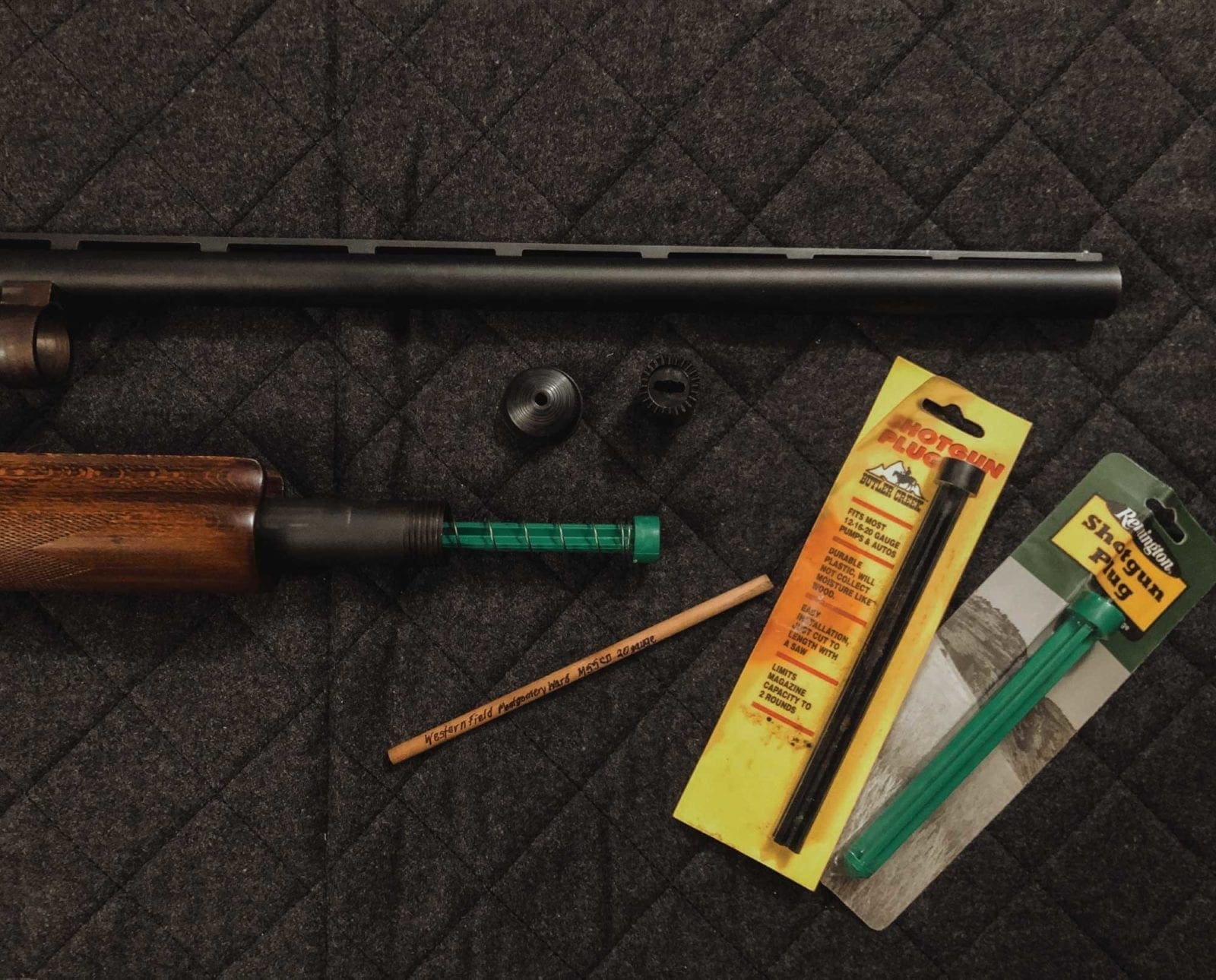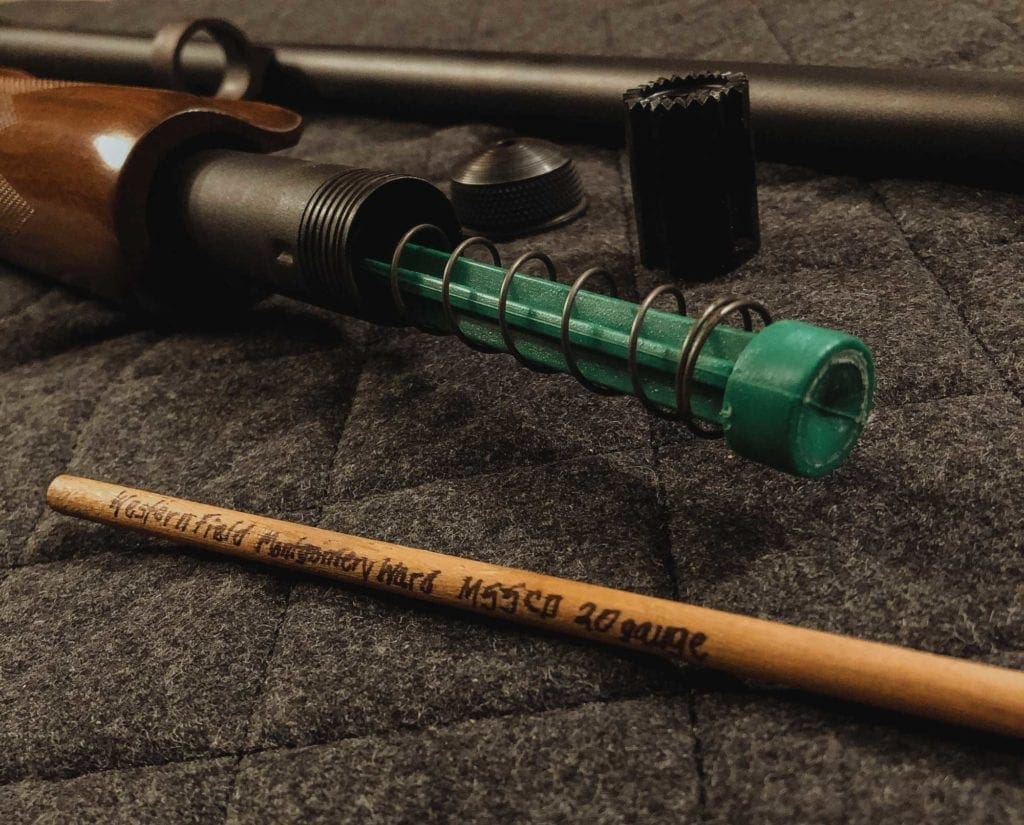Home » Firearms and Shooting » Shotguns » How To Plug a Shotgun in the Field and at Home
How To Plug a Shotgun in the Field and at Home

Edgar Castillo is a recently retired law enforcement officer for…
Limiting yourself to three shells and MacGyvering a plug out of thin air
Truck is parked, and the pump shotgun is pulled from its canvas case. You notice several other vehicles arriving. Dove season is in full swing. A bucket to sit on with mojos away is grabbed and vest pockets are filled to the brim with yellow cartridges. One, two, three, four shells are inserted. Four? Oh, no! No plug! You ask yourself why you removed the plug from the shotgun in the first place? You rationalize the need of more than three shells on a covey rise or when a gaggle of roosters flush out of a milo field in the hopes that a barrage of gunfire knocks down one bird.
Forgetting to replace the plug is a dilemma many hunters face after a long off-season of upland hunting where there are no restrictions to the use of a plug. Well, almost. Upland hunting has a weird way of throwing bird hunters a curve ball when it comes to hunting those species on the fringe. For waterfowling it’s a given. And we all know dove hunting requires a plug, but so does snipe, rail, sora, and yes, even woodcock. These are all classified as migratory birds and under federal law it limits shotguns to three shells.
The inception of the shotgun plug
In the 1930s, the Federal Migratory Bird Treaty Act had amendments placed into its body that strictly regulated the types of firearms used for hunting migratory birds and restricted the capability of a shotgun (pump and semi-automatic) holding more than two shells in the magazine, so its total capacity does not exceed three shells (one in the chamber), as well as using a once-piece filler or “plug” incapable of removal without disassembling the shotgun. The original concept of the plug was that it was to be permanently soldered into the gun so that it could not be removed. We know eventually removable plugs were allowed and were made of wood and then plastic. The reason for the law was in response to the days of market hunting where there were no regulations in curtailing mass shootings of game birds.
How to MacGyver a plug in the field
It doesn’t matter if the shotgun came from the manufacturer without a plug installed and a hunter forgets to check it before taking it to the field; the hunter is in violation. Opening day at least in Kansas seems to bring out the game wardens to check for compliances. One of the first things officers ask is to inspect the shotgun to make sure it has a plug. When that third shell disappears into the magazine tube, a citation is forthcoming. Next, the hunter must somehow magically procure a shotgun plug or figure out what to use instead. This is where creativity sets in and hunters become resourceful in finding things that can be used as plugs. The alternative is to borrow a legal shotgun OR stop hunting.
MacGyver it. Now the scene shifts to hastily figuring out where the plug is or determining what can be used as a makeshift plug. Frantically the hunter starts resorting to Mother Nature for help in finding something to use as a plug; a stick, corn or milo stalk, or cattail stem. Hopefully the hunter is carrying a knife to cut or whittle down whatever is found. The key to using something a-la-natural, is it must be strong enough that it won’t break when shells are inserted.
Hunters wanting to take another path will rummage through their vehicles to find something manmade to act as a plug. Floorboards, glove compartments, center consoles, and tool boxes are where cylindrical items sch as Sharpie markers, pencils and pens, and arrows are found. Once something is found, determining the proper length is the next hurdle. Hopefully a friend or stranger has a “legal” shotgun and its plug can be used for comparison. If not, it becomes trial and error to find the right size for the plug.
WARNING: Hunter’s should use caution when inserting a factory or make-shift stand-in plug, especially if done in the field. Unscrewing and removing parts is delicate. Springs have been known to launch into the atmosphere only to return to Earth landing in a place that is NOT easy to find.

Keeping shotguns plugged
The easiest way to get around from forgetting to put back the plug is to just keep it in the shotgun. Now, I know I may get some flack about this, but this is MY opinion or really, it’s what my father taught me. In his Spanish accent, he told me that a bird hunter doesn’t need more than three shells. By the time the second spent shell is ejected, and the third cartridge is forcibly taking its place, whatever bird is being hunted, there’s already a considerable amount of distance between predator and prey and a third or even fourth shot is pretty much futile. For this reason, I have always kept my plug in all my repeating shotguns. It saves me the trouble of having to remember when I do and don’t need it and I never have to worry about being legal or scramble in finding something to use as a plug.
Most plugs sold are plastic and inexpensive, and advertised as being universal in that they will fit many 12-,16-, and 20-gauges. The image that comes to mind is the green packaged Remington shotgun plug that was a staple in my father’s gun cabinet, shotgun cases, and gun cleaning kits. When visiting the Olathe Gun Shop, my father on occasion would buy an extra plug, not for him but for the poor sap who forgot to plug their shotgun.
Edgar Castillo is a recently retired law enforcement officer for a large Kansas City metropolitan agency. He also served in the United States Marine Corps for twelve years. Edgar longs for the colors of autumn and frosty, winter days so he can explore the landscapes in search of wild birds in wild places. His passion lies in the uplands as he self-documents his travels across public lands throughout Kansas hunting open fields, walking treelines, & bustin’ through plum thickets.





Great article and good to know, especially when an upland hunt might turn into an impromptu waterfowl hunt
I just couldn’t depart your web site prior to suggesting that I extremely enjoyed the standard info a person provide for your visitors? Is gonna be back often to check up on new posts
Thank you for the compliment! Project Upland strives in providing a diverse platform of information for upland hunters. From how-to’s, informative pieces, history, culture, food, etc it’s a central hun for everything upland.
I’m an admittedly late-comer to Turkey Hunting and was just looking up the regulations to Turkey Hunting in Missouri. The shotgun I have does not have a plug in it, so I hit the internet to learn more.
This is exactly the article I needed. Thank you!
What was even cooler is when you Mentioned Olathe Gun Shop, since as it turns out, I was born and raised in Olathe and have been there many times! My uncle even used to work there for a while!
Anyway, thanks again for the article!
Thank you Travis! That’s what Project Upland is about…a general hub of everything upland hunting to include some turkey, waterfowl, and small game hunting. Glad my article provided some insight. Well, if you’re ever at OGS, ask for me. I work one day a week! Good luck with your turkey hunt!